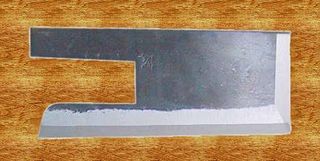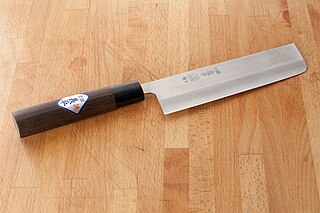 W
WA Japanese kitchen knife is a type of a knife used for food preparation. These knives come in many different varieties and are often made using traditional Japanese blacksmithing techniques. They can be made from stainless steel, or hagane, which is the same kind of steel used to make Japanese swords. Most knives are referred to as hōchō or the variation -bōchō in compound words but can have other names including -kiri . There are four general categories used to distinguish the Japanese knife designs: handle, blade grind, steel, and construction.
 W
WDeba bōchō are Japanese style kitchen knives primarily used to cut fish, though also used when cutting meat. They come in different sizes, sometimes up to 30 cm (12 inches) in length. The deba bōchō first appeared during the Edo period in Sakai. It is designed to behead and fillet fish. Its thickness, and often a more obtuse angle on the back of the heel allow it to cut off the heads of fish without damage. The rest of the blade is then used to ride against the fish bones, separating the fillet. Traditionally, these are made of carbon steel, which needs regular maintenance and oiling to prevent rust. However, many modern knives are also available in stainless steel. The carbon steel blades can be honed into a sharper cutting edge.
 W
WA maguro bōchō , also known as a maguro kiri bōchō is an extremely long, highly specialized Japanese knife that is commonly used fillet tuna, as well as many other types of large ocean fish.
 W
WNakiri bōchō and usuba bōchō are Japanese-style vegetable knives. They differ from the deba bōchō in their shape, as they have a straight blade edge suitable for cutting all the way to the cutting board without the need for a horizontal pull or push. These knives are also much thinner. While the deba bōchō is a heavy blade for easy cutting through thin bones, the blade is not suitable for chopping vegetables, as the thicker blade can break the vegetable slice. The nakiri bōchō and the usuba bōchō have a much thinner blade. This does not help with cutting small bones in fish or meat, but is useful for cutting vegetables.
 W
WThe Santoku bōchō or Bunka bōchō (文化包丁) is a general-purpose kitchen knife originating in Japan. Its blade is typically between 13 and 20 cm long, and has a flat edge and a sheepsfoot blade that curves down an angle approaching 60 degrees at the point. The term Santoku may refer to the wide variety of ingredients that the knife can handle: meat, fish and vegetables, or to the tasks it can perform: slicing, chopping and dicing, either interpretation indicating a multi-use, general-purpose kitchen knife. The Santoku's blade and handle are designed to work in harmony by matching the blade's width and weight to the weight of the tang and the handle.
 W
WThe udon kiri, soba kiri, and kashi kiri are a group of specialized knives used in the Japanese kitchen to make udon and soba noodles respectively. The udon kiri is also sometimes called menkiri bocho, and is distinguished from the Soba and Kashi kiri knives by a blade that drops in to cover less than half of the length of the handle rather that reaching the end of the handle like the soba. The soba kiri is characterized by a long blade that spans down the full length of the handle whereas the blade of the Kashi kiri only curves to meet the top of the handle. To make soba or udon the dough is flattened and folded, and then cut with the menkiri bocho to produce long rectangular noodles. For this purpose the menkiri bocho has a straight and long cutting edge to cut the noodles straight to the board. The knife is usually heavy to aid in the cutting of the noodles, usually with a slight forward motion.
 W
WUsuba bōchō is the traditional vegetable knife for the professional Japanese chef. Like other Japanese professional knives, usuba are chisel ground, and have a bevel on the front side, and have a hollow ground urasuki on the back side. Usuba characteristically have a flat edge, with little or no curve, and are tall, to allow knuckle clearance when chopping on a cutting board. Usuba literally means "thin blade" indicating its relative thinness compared to other knives, required for cutting through firm vegetables without cracking them. Due to its height and straight edge, usuba are also used for specialized cuts such as katsuramuki, shaving a vegetable cylinder into a thin sheet.
 W
WYanagi-ba-bōchō, yanagi ba, or yanagi, is a long and thin knife used in the Japanese cuisine. It is the typical example of the sashimi bōchō used to prepare sashimi and nigiri sushi.